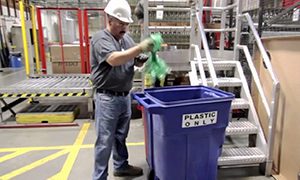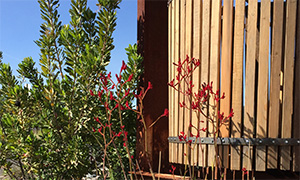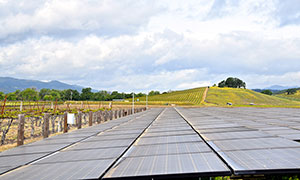Bruce Cakebread and Cakebread Cellars are championing water conservation with their new green parking lot – native trees, drought tolerant grasses and flowers, permeable pavement and bio-swales that capture and filter water and recharge groundwater.
Commented Bruce, “We wanted to do something besides black paving and white stripes. We asked ourselves, ‘where is all of the water going that hits the pavement?’ We decided to go with the model of a green parking lot.”
The expanded parking area, built around existing oak, redwood, pecan, palm and other trees, is safer and more streamlined. The “pavement” consists of light-colored, permeable pavers to reflect heat, atop a foot of gravel, and a drainage system that carries water to three bio-swales. During the two large rain storms in December and February, there were no puddles in the parking lot and the swales filled and drained quickly. “We proved it works,” Cakebread concluded.
Cakebread worked with Landscape Architect Jack Chandler to design the landscaping. The goal is to create the feel of a small forest. They planted 50 new Oak trees of eight different species. They preserved two “squirrel oaks” – trees originally seeded by the squirrels. They also planted almond and olive trees. “My father and grandfather raised almonds outside Brentwood in the 1940s, 50s, and 60s so this pays homage to that history,” Cakebread said. They currently make and sell about 50 gallons of olive oil from olive trees around the winery. All of the landscaping is irrigated with recycled water from their reclamation pond and lit by efficient LED lights.
“Employees and guests used to make a beeline to the facility. We built a path from the back parking area through the swales and trees to encourage guests and employees to enjoy the walk. If we’re going to take care of our winery footprint we also want to help our employees educate themselves about being healthy.”
The parking spaces are filled with shallow gravel supported by honeycomb – a web of circular piping that supports vehicle weight and directs water down to the drainage system. Along the sides is grass pave , water efficient, low-maintenance hardy grass also supported by the honeycomb, so limos and buses can park there as needed. Cakebread Cellars started the project in the spring of 2014 and it was largely complete by late-fall. There are 89 guest and 32 employee parking spaces. They’re currently working on signage for each parking bay that will tell the history of Cakebread Cellars, the Napa Valley and what you see in the parking and landscaping.
“We’ve been here 43 years and we want to be here another 43 years,” said Cakebread. “Projects like this not only allow for reduced runoff, purified storm water and flood prevention, but they also allow us to plant new crops and expand biodiversity on the property. This project wasn’t driven by Napa County or permits, just our own desire to be good stewards.”

Trinchero Family Estates has made waste reduction part of their company-wide DNA.

Reducing resources is serious business at the NVV. Get some ideas and tips for going green.
 Saving Energy With Solar
Saving Energy With SolarA PG&E energy audit launched a decade of energy conservation practices at Honig Vineyard & Winery.